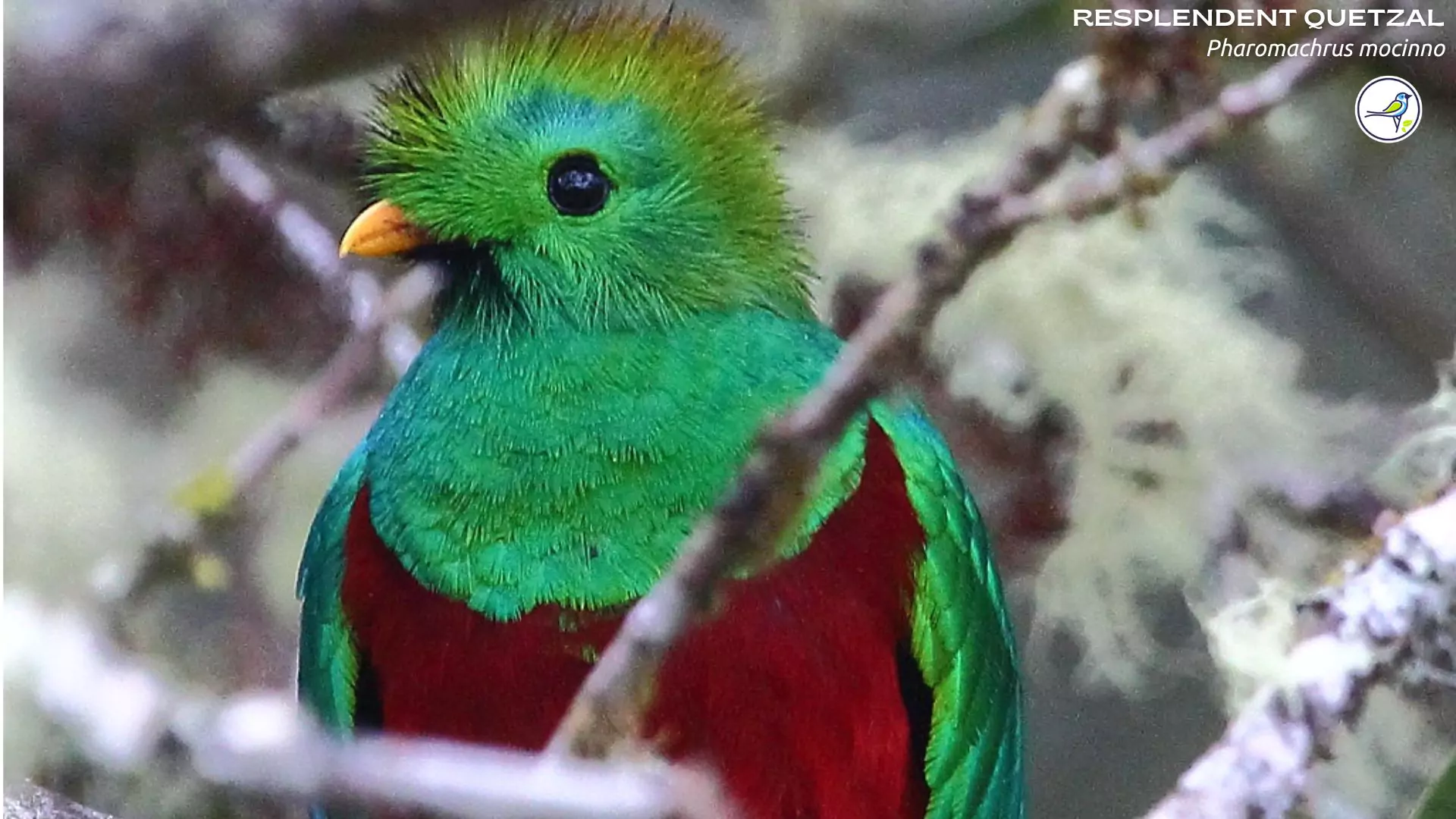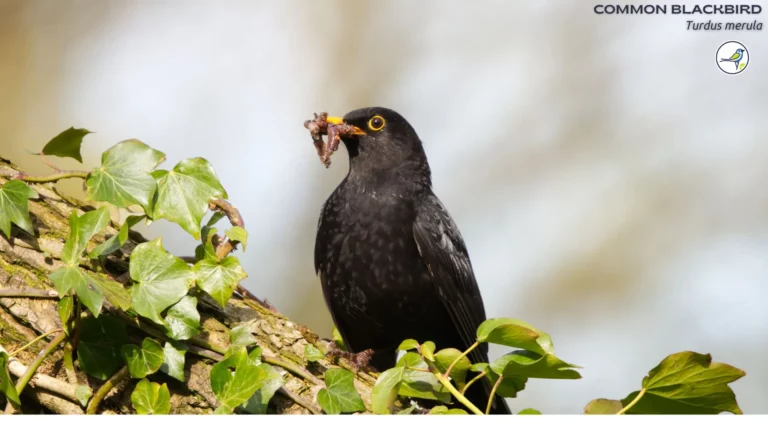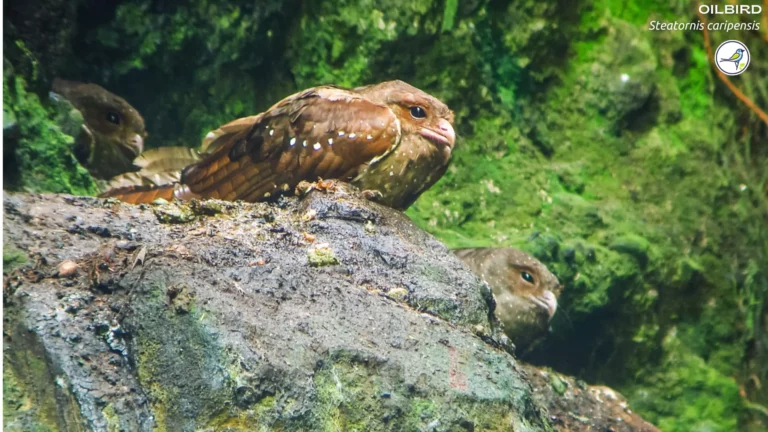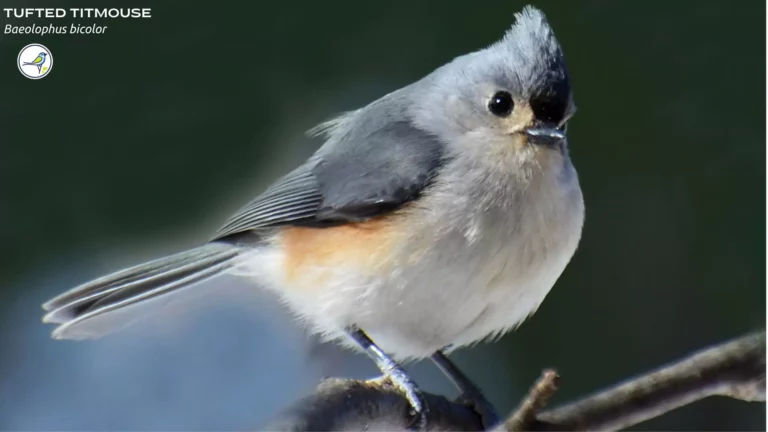7 of the World’s Most Different Exotic Birds
When it comes to the natural world, few creatures captivate our imagination and stir our wonder like exotic birds. These avian wonders are the epitome of nature’s artistry, showcasing an incredible spectrum of colors, shapes, and behaviors that seem almost otherworldly. In this blog post, we embark on a colorful journey to explore the diverse and enchanting world of exotic birds. Exotic birds stand out from the avian crowd for a multitude of reasons. They possess striking plumage that seems to have been painted by an artist’s brush, often in vibrant hues that defy belief. Their distinctive behaviors, intricate courtship rituals, and unique adaptations further set them apart. But what truly makes these birds exotic is the fact that they are often found in far-flung corners of the globe, in some of the most remote and exotic locales imaginable.
The allure of exotic birds lies not only in their physical beauty but also in the air of mystery that surrounds them. They serve as ambassadors of biodiversity, reminding us of the astonishing diversity of life on our planet. However, many of these remarkable species are facing unprecedented challenges due to habitat loss, climate change, and illegal trade, making the need for conservation efforts more critical than ever. Throughout this blog post, we will delve into the lives of some of the world’s most remarkable and sought-after exotic birds. From the resplendent Quetzal of Central America to the elusive Kakapo of New Zealand, each species has a unique story to tell, a testament to the astonishing tapestry of life on Earth.
By the end of this journey, we hope to not only have introduced you to these extraordinary creatures but also to inspire a sense of appreciation and responsibility for their conservation. Together, we can play a role in safeguarding these avian wonders for generations to come. So, without further ado, let’s spread our wings and explore the vibrant world of exotic birds.
What Makes a Bird Exotic?
In the realm of ornithology and bird enthusiasts, the term “exotic” isn’t just about being rare or unusual; it’s a testament to the extraordinary. Exotic birds are a unique subset of the avian world, distinguished by several remarkable characteristics that set them apart from their more commonplace counterparts.
1. Vibrant Plumage and Aesthetic Beauty: One of the defining features of exotic birds is their captivating plumage. These birds often sport a kaleidoscope of colors that can rival the most vibrant rainbows. From the iridescent blues and greens of the Hyacinth Macaw to the fiery reds and yellows of the Scarlet Macaw, their plumage is a living palette of nature’s most brilliant hues. Such extraordinary colors are often used in courtship displays, making them all the more mesmerizing.
2. Unique Adaptations and Behaviors: Exotic birds also exhibit distinctive behaviors and adaptations that make them stand out. Whether it’s the Resplendent Quetzal’s acrobatic flights through dense forests or the Wilson’s Bird-of-Paradise’s elaborate courtship rituals, these birds have evolved unique strategies for survival and reproduction.
3. Habitats Beyond the Ordinary: What adds to their allure is their choice of habitats. Exotic birds are often found in remote and exotic locations, far from the bustling urban centers. These habitats, which can include lush rainforests, remote islands, and high-altitude cloud forests, contribute to their aura of mystique.
4. Conservation and the Rarity Factor: Lastly, the rarity of these birds plays a significant role in their exotic status. Many exotic bird species are considered threatened or endangered due to habitat destruction and poaching. This rarity adds to their mystique and emphasizes the importance of conservation efforts to protect them.
5. Appreciating Avian Exotica: As we delve deeper into this blog post, we’ll introduce you to some of the most astonishing exotic bird species on our planet. Each one is a testament to the awe-inspiring diversity of life, and together, they form a symphony of colors, behaviors, and adaptations that celebrate the beauty of our natural world. Join us on this journey to discover the breathtaking world of exotic birds and learn more about what makes them truly extraordinary.
Scarlet Macaw (Ara macao)
- The Vibrant Icon of the Tropics: When we think of exotic birds, the Scarlet Macaw immediately comes to mind. With its resplendent plumage and charismatic presence, this parrot species is a true icon of the tropics. In this section, we’ll dive deep into the world of the Scarlet Macaw, exploring its vivid appearance, natural habitat, conservation status, and fascinating behaviors.
- A Riot of Colors: The Scarlet Macaw is a dazzling showcase of nature’s artistry. Its feathers are a symphony of colors, with deep scarlet plumage covering most of its body, complemented by brilliant blue wings and a vibrant yellow and blue tail. Its face is adorned with striking white patches around the eyes, which add to its striking appearance. This vibrant plumage isn’t just for show; it serves as both camouflage and a form of communication among these social birds.

- The Habitat of the Scarlet Macaw: This iconic parrot calls the dense rainforests of Central and South America its home. They are often found in countries like Costa Rica, Panama, and Brazil, where they inhabit the canopy of these lush forests. The towering trees provide them with nesting sites and a diverse diet of fruits, nuts, seeds, and even the occasional insect.
- Conservation Concerns: While the Scarlet Macaw’s beauty is undeniable, its future in the wild is uncertain. Habitat loss due to deforestation and the illegal pet trade have taken a toll on their populations. As a result, the Scarlet Macaw is classified as near threatened by the International Union for Conservation of Nature (IUCN). However, conservation efforts, including habitat protection and breeding programs, are underway to ensure the survival of this magnificent species.
- Intriguing Behaviors: Scarlet Macaws are known for their social and intelligent nature. They form tight-knit family groups and communicate through a range of vocalizations, including loud squawks and calls. They are also skilled flyers, capable of soaring gracefully through the treetops. Mating rituals involve elaborate displays of affection, strengthening the bonds within their flocks.
Resplendent Quetzal (Pharomachrus mocinno)
- The Elusive Jewel of Central America: In the verdant forests of Central America, there exists a bird so enchanting that it has become a symbol of beauty and freedom. The Resplendent Quetzal, with its ethereal plumage and mystical aura, holds a special place in the hearts and folklore of the region. In this section, we’ll immerse ourselves in the world of the Resplendent Quetzal, exploring its breathtaking appearance, its lush Central American habitat, cultural significance, and ongoing conservation efforts.
- A Living Gemstone: The Resplendent Quetzal is renowned for its iridescent plumage that shimmers with shades of emerald green and ruby red. Its tail feathers are exceptionally long and elegant, often extending twice the length of its body. This unique feature, with its iridescent feathers, is believed to have been a symbol of freedom and divinity for ancient Mesoamerican civilizations.

- The Cloud Forests of Central America: These magnificent birds call the cloud forests of Central America home, inhabiting regions ranging from southern Mexico to Panama. These lush and misty montane forests provide the perfect backdrop for the Resplendent Quetzal’s vibrant colors, and they are well-adapted to life in these elevated environments. They feed primarily on fruits, insects, and the occasional small vertebrate.
- Cultural Significance: Throughout history, the Resplendent Quetzal has held immense cultural significance, particularly among the Mayan and Aztec civilizations. It was considered the “god of the air” and was often associated with freedom, divinity, and the cycles of life. The quetzal’s feathers were highly prized and used in the creation of ceremonial regalia for nobility, adding to its allure and mystique.
- Conservation and Preservation: Despite its cultural importance, the Resplendent Quetzal faces modern-day challenges. Habitat destruction and fragmentation, caused by deforestation, are among the primary threats to its survival. Conservation organizations and local communities are working tirelessly to protect these forests and the quetzal’s habitat. Ecotourism initiatives also play a crucial role in raising awareness and providing sustainable funding for conservation efforts.
- Witnessing the Quetzal’s Magic: The Resplendent Quetzal remains one of the most sought-after sightings for birdwatchers and nature enthusiasts. To witness the quetzal’s magic in person is to be touched by the enchantment of the natural world. As we continue our journey through the world of exotic birds, we invite you to delve deeper into the beauty, symbolism, and conservation significance of the Resplendent Quetzal, a living jewel of Central America’s cloud forests.
Harpy Eagle (Harpia harpyja)
- The Majestic Ruler of the Rainforest Canopy: In the heart of the lush tropical rainforests of Central and South America, a true apex predator soars. The Harpy Eagle, with its imposing size, powerful build, and majestic appearance, is often considered the king of the canopy. In this section, we will delve into the world of the Harpy Eagle, exploring its impressive physical attributes, unique hunting habits, conservation status, and the challenges it faces in its natural habitat.
- A Regal Presence: The Harpy Eagle commands attention with its grandeur. It is one of the largest and most powerful eagles globally, boasting a wingspan that can reach up to 7 feet and talons as long as a grizzly bear’s claws. Its striking appearance includes a crown of feathers atop its head, which gives it an almost regal demeanor.
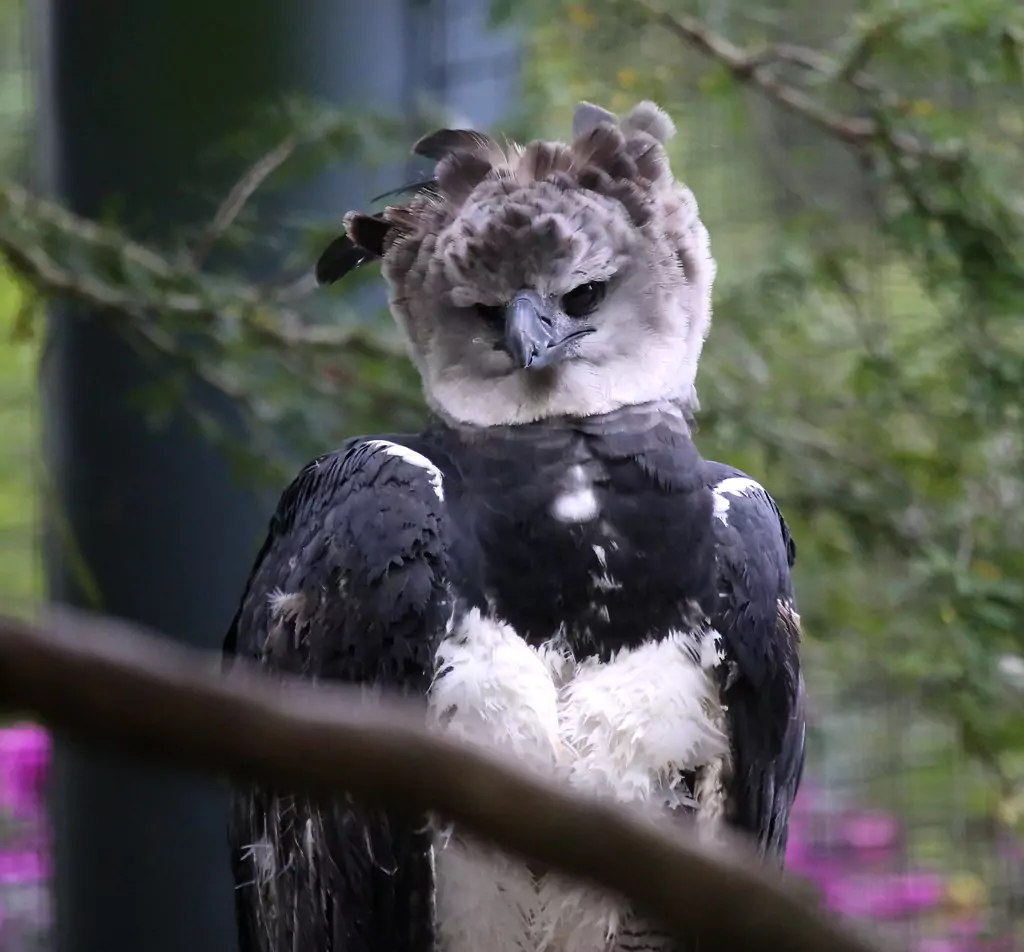
- Master of the Canopy: This avian monarch reigns supreme in the treetops of dense tropical rainforests. Its preferred habitat includes the Amazon Basin, the forests of Central America, and other remote areas where it can find ample prey. Harpy Eagles are experts at navigating the complex, dense foliage of the rainforest canopy, which they use to their advantage when hunting.
- A Predator’s Diet: The Harpy Eagle is a formidable carnivore, preying on a variety of mammals and birds. Its menu includes tree-dwelling animals like sloths, monkeys, and various species of birds. It is an ambush predator, often perching silently in wait for its unsuspecting prey to pass by below, then striking with incredible speed and precision.
- Conservation Challenges: Despite its commanding presence, the Harpy Eagle faces significant conservation challenges. Habitat loss due to deforestation and human encroachment into its territory are major threats. Additionally, the slow reproductive rate of Harpy Eagles makes them vulnerable to population declines. Conservation efforts focus on protecting their habitats, minimizing human disturbance, and monitoring their populations.
- Preserving the Majesty of the Harpy Eagle: Witnessing a Harpy Eagle in the wild is a rare and awe-inspiring experience, but it’s one that requires our collective efforts to ensure its future. As we continue our journey through the world of exotic birds, let us appreciate the majesty of the Harpy Eagle and recognize the importance of preserving the grandeur of the rainforest canopy, which it calls home. Join us in exploring the remarkable world of this avian monarch and the vital role it plays in the delicate balance of tropical ecosystems.
Wilson’s Bird-of-Paradise (Cicinnurus respublica)
- The Tiny Jewel of Indonesian Isles: In the remote and lush islands of Indonesia, a miniature masterpiece of nature awaits discovery. Wilson’s Bird-of-Paradise, with its strikingly vibrant plumage and mesmerizing courtship displays, is a living testament to the astonishing diversity of life on Earth. In this section, we embark on a journey to the Indonesian islands, where we’ll unveil the captivating world of Wilson’s Bird-of-Paradise, exploring its dazzling appearance, unique habitat, role in evolutionary biology, and its remarkable mating rituals.
- A Burst of Color: Wilson’s Bird-of-Paradise is a true avian gem, known for its exquisite and compact appearance. Males of this species exhibit a flamboyant combination of bright turquoise, emerald green, and fiery red feathers. Its unique and elaborate plumage has earned it the nickname “the most beautiful bird in the world.”
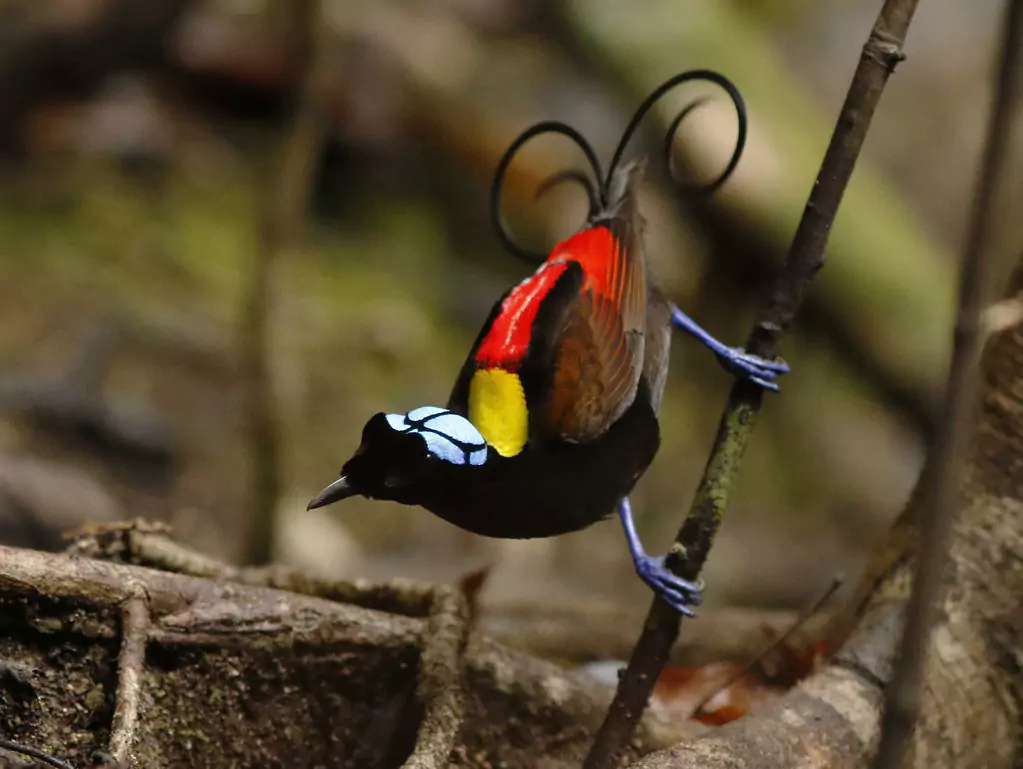
- Island Retreats: These small wonders are endemic to the islands of Indonesia, with their primary habitat located in the lowland rainforests of the islands of Waigeo and Batanta in West Papua. These islands provide the perfect backdrop for their vibrant plumage, as well as the lush vegetation and clearings where they engage in their intricate courtship dances.
- A Study in Evolutionary Marvels: Wilson’s Bird-of-Paradise is not only a visual marvel but also a subject of great scientific interest. Charles Darwin himself was fascinated by these birds and their bizarre courtship displays. Their unique behaviors and adaptations have played a role in advancing our understanding of sexual selection and evolutionary biology.
- Intricate Courtship Rituals: During the breeding season, male Wilson’s Bird-of-Paradise engage in mesmerizing courtship displays to win the favor of females. These displays involve intricate dances and the exhibition of their striking plumage. Their rituals are a testament to nature’s creativity in the pursuit of reproduction.
- Conservation Concerns and Efforts: As with many exotic birds, Wilson’s Bird-of-Paradise faces threats to its survival, primarily due to habitat destruction caused by deforestation. Conservation initiatives, including protected areas and community-based conservation efforts, are vital in safeguarding these birds and their unique habitat.
- Embrace the Enchantment: Wilson’s Bird-of-Paradise serves as a reminder that even the tiniest of creatures can be among the most extraordinary. As we delve deeper into the world of exotic birds, we invite you to embrace the enchantment of this Indonesian jewel, appreciate its significance in the study of evolution, and support the conservation endeavors that ensure its continued presence in the lush rainforests of Indonesia. Join us in celebrating the vibrant world of Wilson’s Bird-of-Paradise, a true testament to the marvels of nature.
Hyacinth Macaw (Anodorhynchus hyacinthinus)
- The Mighty Giant of Parrots: In the heart of South America’s tropical forests, a true avian giant reigns supreme. The Hyacinth Macaw, with its striking cobalt-blue plumage and commanding presence, is the largest parrot species on Earth. In this section, we’ll delve into the world of the Hyacinth Macaw, exploring its magnificent appearance, natural habitat in South America, conservation status, and the challenges it faces as a symbol of the wild.
- A Blue Marvel: Hyacinth Macaws are truly a spectacle to behold. Their plumage is a vibrant shade of deep blue, complemented by striking yellow eye patches and bill. This resplendent coloration makes them one of the most visually captivating birds in the world. Their size is equally impressive, with wingspans that can reach up to four feet.

- Tropical South American Oasis: These magnificent parrots are primarily found in the tropical forests of South America, spanning regions from Brazil to Bolivia. They favor habitats near water sources like rivers and swamps, where they feed on a diverse diet of fruits, nuts, and seeds. Their unique bill shape allows them to crack open even the toughest nuts, making them efficient foragers.
- Conservation Challenges: Despite their majestic presence, Hyacinth Macaws are facing significant conservation challenges. Habitat loss due to deforestation, as well as illegal trapping for the pet trade, has led to population declines. They are listed as vulnerable by the International Union for Conservation of Nature (IUCN), emphasizing the need for conservation efforts to protect these giants of the parrot world.
- Complex Social Structure: Hyacinth Macaws are known for their complex social structures and strong family bonds. They form tight-knit family groups and communicate through various vocalizations, including loud calls that can be heard over long distances. These social behaviors are vital for their survival and reproduction.
- Guardians of Biodiversity: Beyond their stunning appearance, Hyacinth Macaws play a crucial role in the ecosystems they inhabit. They help disperse seeds of the fruits they consume, contributing to forest regeneration and biodiversity maintenance.
Kakapo (Strigops habroptilus)
- The Enigmatic Night Parrot of New Zealand: In the remote and mystical landscapes of New Zealand, a truly enigmatic parrot resides. The Kakapo, with its nocturnal habits, flightlessness, and peculiar appearance, is a living relic of evolutionary history. In this section, we embark on a journey to the isolated islands of New Zealand, where we’ll uncover the world of the Kakapo, exploring its unique features, natural habitat, the incredible story of its recovery from near extinction, and the ongoing efforts to protect this rare and treasured species.
- A Remarkable Relic: The Kakapo stands out in the avian world for its distinct features. It’s a large, robust parrot with mossy-green plumage that blends seamlessly with its forested habitat. With a distinctive owl-like face, large wings (despite its flightlessness), and a reputation for being the heaviest parrot in the world, the Kakapo is a true anomaly among parrots.
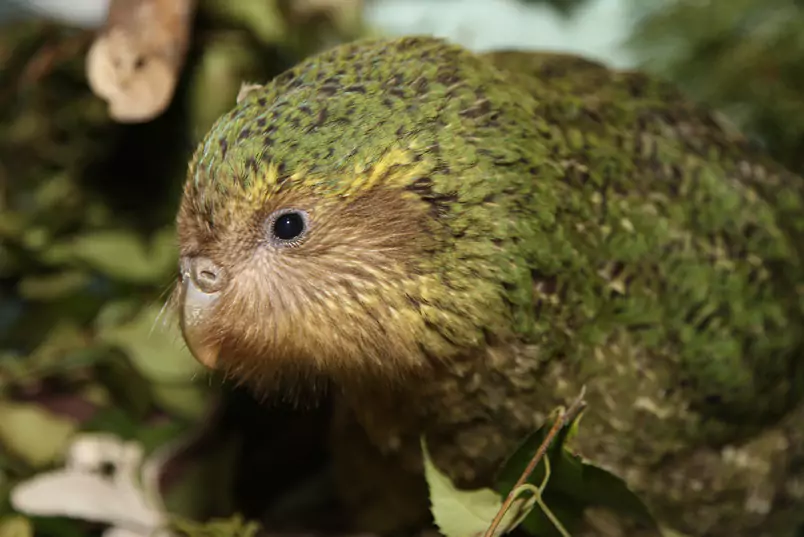
- Island Sanctuary: Kakapos are endemic to New Zealand, primarily inhabiting the country’s remote islands, including Codfish Island and Anchor Island. These isolated sanctuaries provide a refuge for these nocturnal birds, where they can forage for their preferred diet of fruits, leaves, and native plants.
- A Tale of Resilience: The story of the Kakapo is one of remarkable resilience. Once thought to be extinct, a small population was rediscovered in the 1970s, leading to intense conservation efforts. Today, their numbers have increased, albeit modestly, thanks to dedicated conservationists, intensive management, and innovative techniques like hand-rearing chicks.
- Challenges and Conservation: While progress has been made, Kakapos still face significant challenges. Their population remains critically endangered due to habitat loss, introduced predators, and low reproductive rates. Conservation initiatives include predator control, supplementary feeding, and carefully managed breeding programs.
- Nocturnal Mystique: Kakapos are renowned for their nocturnal habits, often foraging under the cover of darkness. Their distinctive calls, known as “booms,” are used by males to attract females during the breeding season, creating an eerie yet captivating soundscape in the New Zealand forests.
African Grey Parrot (Psittacus erithacus)
- The Genius Talker of African Rainforests: In the heart of Africa’s lush rainforests, a parrot species stands out for its extraordinary intelligence and unparalleled ability to mimic sounds. The African Grey Parrot, with its distinctive gray plumage and exceptional cognitive abilities, is often considered one of the world’s most intelligent birds. In this section, we venture into the African rainforests, where we’ll discover the remarkable world of the African Grey Parrot, exploring its appearance, natural range in Africa, its role as a popular pet, and the challenges it faces in the wild.
- A Feathered Intellectual: The African Grey Parrot is renowned for its distinctive gray plumage, which is complemented by a bright red tail. Beyond its appearance, it is celebrated for its remarkable cognitive abilities. These parrots are renowned for their problem-solving skills, complex vocalizations, and exceptional ability to mimic human speech and other sounds.
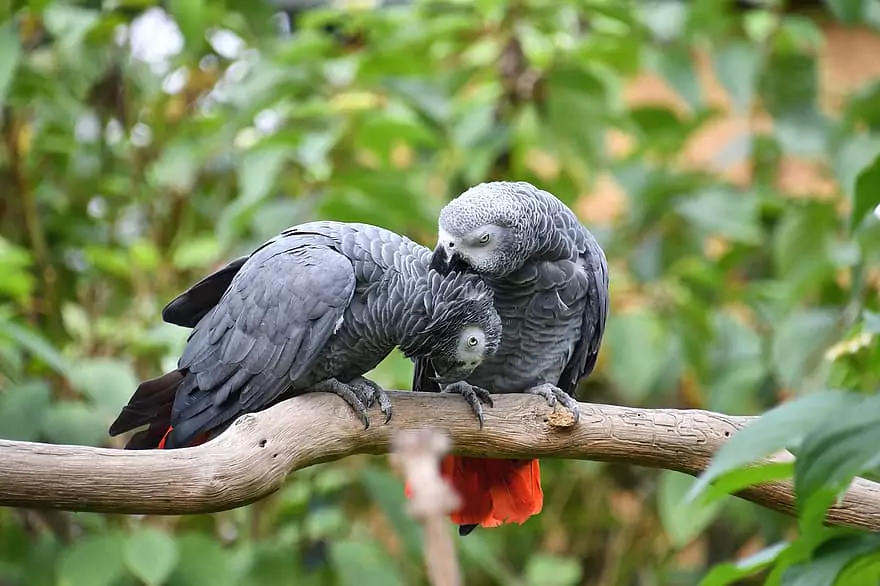
- African Rainforest Habitat: These avian intellectuals are native to the dense rainforests of West and Central Africa, with their range spanning from countries like Ghana and Côte d’Ivoire to Congo and Uganda. In the wild, they primarily feed on a diet of fruits, nuts, seeds, and vegetation.
- Popular Pet Parrot: The African Grey Parrot’s high intelligence and ability to mimic human speech have made it a sought-after pet worldwide. However, this popularity has also led to overexploitation and illegal wildlife trade, resulting in population declines in the wild.
- Conservation Challenges: African Grey Parrots face numerous conservation challenges, including habitat loss due to deforestation and unsustainable trapping for the pet trade. These factors have contributed to their decline in the wild, leading to their classification as vulnerable by the International Union for Conservation of Nature (IUCN).
- Responsible Pet Ownership: As pets, African Grey Parrots require special care, attention, and mental stimulation to thrive. It’s essential for prospective owners to research and understand the responsibilities involved in keeping these intelligent birds as pets. Supporting captive breeding programs and adopting from reputable sources can help reduce demand for wild-caught birds.
- Appreciating Intelligence in the Avian World: As we continue our journey through the world of exotic birds, we invite you to appreciate the extraordinary intelligence and uniqueness of the African Grey Parrot. By learning more about these remarkable birds and the challenges they face in their natural habitat, we can work towards their conservation and ensure their place as both a symbol of avian intelligence and a cherished pet companion. Join us in celebrating the intellect and charm of the African Grey Parrot, a feathered genius in the heart of African rainforests.
Our exploration of exotic birds has revealed a world of vibrant colors and fascinating behaviors. These remarkable creatures are not only a testament to nature’s artistry but also ambassadors of biodiversity. As we conclude, it’s crucial to recognize the importance of conservation. Habitat loss, illegal trade, and climate change threaten their existence.
To make a difference, raise awareness about these issues, support conservation organizations, and advocate for sustainable practices. Education is key; understanding these birds’ natural behaviors and challenges is the first step towards their preservation.
By appreciating and sharing our knowledge, we become advocates for their protection. Let’s work together to ensure that the world’s most exotic birds continue to grace our skies and inspire wonder for generations to come. The journey is ongoing, and our collective efforts can make a significant impact. Thank you for joining us on this colorful and educational adventure.

